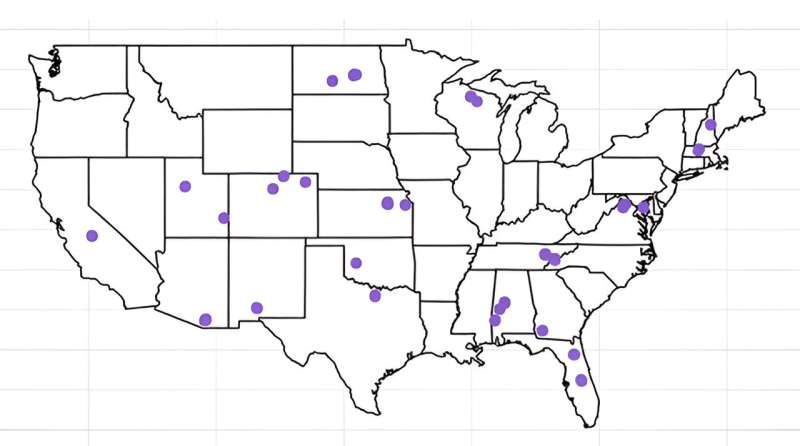This article has been reviewed according to Science X's editorial process and policies. Editors have highlighted the following attributes while ensuring the content's credibility:
fact-checked
trusted source
proofread
Can soil microbes survive in a changing climate?

Organisms across the globe are facing unprecedented levels of stress from climate change, habitat destruction, and many other human-driven changes to the environment. Predicting and mitigating the effects of this increasing stress on organisms, and the environmental services on which we depend, requires understanding why some species can exist in a wide range of environments while others exist in only a few habitats.
In the scientific world of ecology, researchers often try to sort organisms on our planet into two categories: specialists and generalists. Generalists can survive across various environmental conditions and habitats, while specialists are more restricted or limited to specific conditions for survival. The panda bear, for example, feeds only on bamboo within a specific habitat. Not only is their habitat range-restricted, but so is their diet, and if the bamboo plant became extinct, panda bears might become extinct as well.
But what about the microbial world of unseen organisms found everywhere on Earth, from the human gut to the soil under our feet? Into which category do they fall?
To find the answer, a group of graduate and postdoc students in Associate Professor Michelle Afkhami's biology lab at the University of Miami College of Arts and Sciences studied the DNA sequences of prokaryotes, a group of microbes that include all bacteria and archaea.
The findings are in a study, titled "Multidimensional specialization and generalization are pervasive in soil prokaryotes," available in the journal Nature Ecology & Evolution.
"The idea behind the project was to find out whether these microbes can exist within a narrow or broad range of conditions along many different environmental dimensions," said Damian Hernandez, a former graduate student in Afkhami's lab and now a postdoc preparing for a biology fellowship with the National Science Foundation.
"Specifically, we wanted to know whether microbes are typically multidimensional specialists, multidimensional generalists, or use different strategies on different environmental dimensions—and what effect that could have on their roles within communities.
"The environmental dimensions we used to determine whether the microbes are generalists or specialists were based on multiple environmental conditions in the soil in which they live, for example, leaf litter, temperature, water, and nutrients," he added.
In a collaborative effort two years in the making, the team of students analyzed over 200 soil samples collected by the National Ecological Observatory Network (NEON) from sites across the United States. Of the over 1,200 prokaryotes examined, Hernandez and the team found something quite surprising. They found that the majority (90 percent) of the microbes were either multidimensional generalists or multidimensional specialists.
Essentially, if a microbe was a generalist across one environmental axis, it was almost always a generalist across all other axes; and if it was a specialist on one environmental axis, it specialized across all axes. In addition to providing important insight into how microbial communities are structured, this discovery provides some of the first evidence for multidimensional specialization and generalization in any type of organism.
"We found that microbes can be very restricted on where they can exist," said Hernandez, who is the first author of the study. "The generalist microbes are very flexible and can withstand a broader range of conditions. But the specialist microbes are sensitive to many different environmental conditions because they are restricted on multiple environmental axes and thus any changes in the environment may hinder their survival.
"Hypothetically, if an ecosystem is structured by microbes that are specialists, then those ecosystems are more likely to be sensitive to environmental change," he said.
Afkhami confirms that the findings present an interesting argument on how microbes can survive in a changing climate.
"As we learned from the study, microbes that are generalists can live across a wide range of habitats, and this can mean that those microbes may be resilient to climate change or habitat fragmentation because they are likely to tolerate changing environmental conditions. They are also very dominant within microbial communities," she said.
In contrast, the team found that specialist microbes can be very susceptible to environmental change. Microbes categorized as specialists also appear to be important "community organizers" due to their high functionality within the microbial world. For example, the research team discovered that specialist microbes are more likely to be those that can promote plant growth, detoxify the soil, digest complex carbons in the soil, and add nutrients to the soil.
"This is very concerning because what we also learned in the study is that microbial specialists are highly connected within the microbial network and can be considered as keystone species for maintaining and driving the diversity and function of the microbiome," said Afkhami.
"In this study, we can start to understand—across a wider sense in the microbiome community—some of their biological functions, their roles in the microbial community, and how they will respond to global changes on the planet."
More information: Damian J. Hernandez et al, Multidimensional specialization and generalization are pervasive in soil prokaryotes, Nature Ecology & Evolution (2023). DOI: 10.1038/s41559-023-02149-y
Provided by University of Miami



















